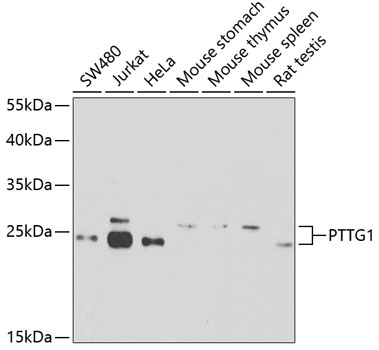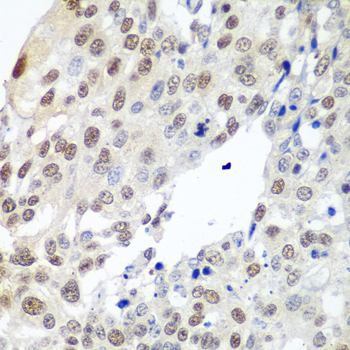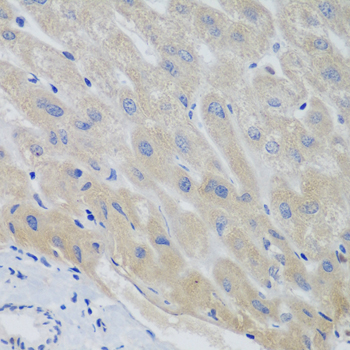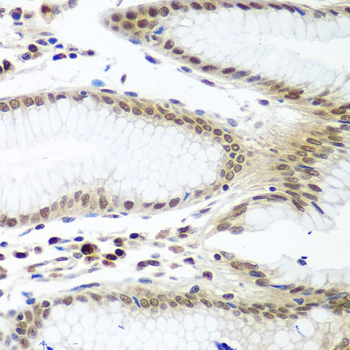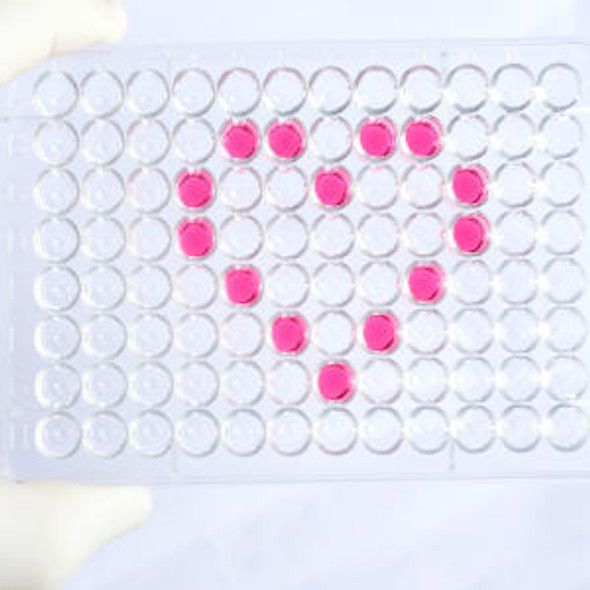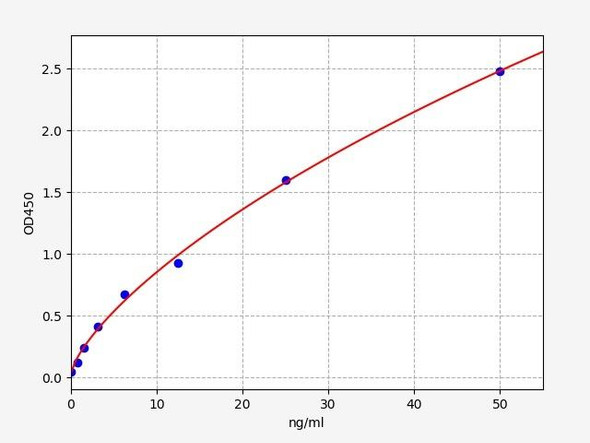Cell Cycle Antibodies 2
Anti-Securin Antibody (CAB8307)
- SKU:
- CAB8307
- Product Type:
- Antibody
- Applications:
- WB
- Applications:
- IHC
- Reactivity:
- Human
- Reactivity:
- Mouse
- Reactivity:
- Rat
- Host Species:
- Rabbit
- Isotype:
- IgG
- Research Area:
- Cell Cycle
Description
| Antibody Name: | PTTG1 Rabbit Polyclonal Antibody |
| Antibody SKU: | CAB8307 |
| Antibody Size: | 20uL, 50uL, 100uL |
| Application: | WB IHC |
| Reactivity: | Human, Mouse, Rat |
| Host Species: | Rabbit |
| Immunogen: | Recombinant fusion protein containing a sequence corresponding to amino acids 1-202 of human PTTG1 (NP_001269311.1). |
| Application: | WB IHC |
| Recommended Dilution: | WB 1:500 - 1:2000 IHC 1:100 - 1:200 |
| Reactivity: | Human, Mouse, Rat |
| Positive Samples: | SW480, Jurkat, HeLa, Mouse stomach, Mouse thymus, Mouse spleen, Rat testis |
| Immunogen: | Recombinant fusion protein containing a sequence corresponding to amino acids 1-202 of human PTTG1 (NP_001269311.1). |
| Purification Method: | Affinity purification |
| Storage Buffer: | Store at -20'C. Avoid freeze / thaw cycles. Buffer: PBS with 0.02% sodium azide, 50% glycerol, pH7.3. |
| Isotype: | IgG |
| Sequence: | MATL IYVD KENG EPGT RVVA KDGL KLGS GPSI KALD GRSQ VSTP RFGK TFDA PPAL PKAT RKAL GTVN RATE KSVK TKGP LKQK QPSF SAKK MTEK TVKA KSSV PASD DAYP EIEK FFPF NPLD FESF DLPE EHQI AHLP LSGV PLMI LDEE RELE KLFQ LGPP SPVK MPSP PWES NLLQ SPSS ILST LDVE LPPV CCDI DI |
| Gene ID: | 9232 |
| Uniprot: | O95997 |
| Cellular Location: | Cytoplasm, Nucleus |
| Calculated MW: | 22kDa |
| Observed MW: | 24kDa |
| Synonyms: | PTTG1, EAP1, HPTTG, PTTG, TUTR1, securin |
| Background: | The encoded protein is a homolog of yeast securin proteins, which prevent separins from promoting sister chromatid separation. It is an anaphase-promoting complex (APC) substrate that associates with a separin until activation of the APC. The gene product has transforming activity in vitro and tumorigenic activity in vivo, and the gene is highly expressed in various tumors. The gene product contains 2 PXXP motifs, which are required for its transforming and tumorigenic activities, as well as for its stimulation of basic fibroblast growth factor expression. It also contains a destruction box (D box) that is required for its degradation by the APC. The acidic C-terminal region of the encoded protein can act as a transactivation domain. The gene product is mainly a cytosolic protein, although it partially localizes in the nucleus. Three transcript variants encoding the same protein have been found for this gene. |
| UniProt Protein Function: | Securin: Regulatory protein, which plays a central role in chromosome stability, in the p53/TP53 pathway, and DNA repair. Probably acts by blocking the action of key proteins. During the mitosis, it blocks Separase/ESPL1 function, preventing the proteolysis of the cohesin complex and the subsequent segregation of the chromosomes. At the onset of anaphase, it is ubiquitinated, conducting to its destruction and to the liberation of ESPL1. Its function is however not limited to a blocking activity, since it is required to activate ESPL1. Negatively regulates the transcriptional activity and related apoptosis activity of TP53. The negative regulation of TP53 may explain the strong transforming capability of the protein when it is overexpressed. May also play a role in DNA repair via its interaction with Ku, possibly by connecting DNA damage-response pathways with sister chromatid separation. Belongs to the securin family. |
| UniProt Protein Details: | Protein type:Oncoprotein; Cell cycle regulation Chromosomal Location of Human Ortholog: 5q35.1 Cellular Component: cytoplasm; cytosol Molecular Function:protease inhibitor activity; protein binding; transcription factor activity Biological Process: anaphase-promoting complex-dependent proteasomal ubiquitin-dependent protein catabolic process; homologous chromosome segregation; protein ubiquitination during ubiquitin-dependent protein catabolic process; spermatogenesis; transcription from RNA polymerase II promoter |
| NCBI Summary: | The encoded protein is a homolog of yeast securin proteins, which prevent separins from promoting sister chromatid separation. It is an anaphase-promoting complex (APC) substrate that associates with a separin until activation of the APC. The gene product has transforming activity in vitro and tumorigenic activity in vivo, and the gene is highly expressed in various tumors. The gene product contains 2 PXXP motifs, which are required for its transforming and tumorigenic activities, as well as for its stimulation of basic fibroblast growth factor expression. It also contains a destruction box (D box) that is required for its degradation by the APC. The acidic C-terminal region of the encoded protein can act as a transactivation domain. The gene product is mainly a cytosolic protein, although it partially localizes in the nucleus. Three transcript variants encoding the same protein have been found for this gene. [provided by RefSeq, Sep 2013] |
| UniProt Code: | O95997 |
| NCBI GenInfo Identifier: | 29336594 |
| NCBI Gene ID: | 9232 |
| NCBI Accession: | O95997.1 |
| UniProt Related Accession: | O95997 |
| Molecular Weight: | |
| NCBI Full Name: | Securin |
| NCBI Synonym Full Names: | pituitary tumor-transforming 1 |
| NCBI Official Symbol: | PTTG1 |
| NCBI Official Synonym Symbols: | EAP1; PTTG; HPTTG; TUTR1 |
| NCBI Protein Information: | securin |
| UniProt Protein Name: | Securin |
| UniProt Synonym Protein Names: | Esp1-associated protein; Pituitary tumor-transforming gene 1 protein; Tumor-transforming protein 1; hPTTG |
| UniProt Gene Name: | PTTG1 |
| UniProt Entry Name: | PTTG1_HUMAN |
View AllClose


